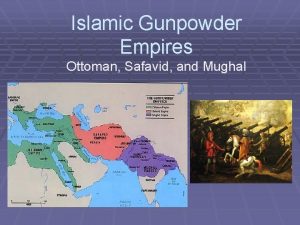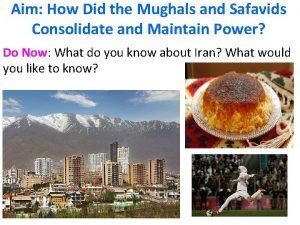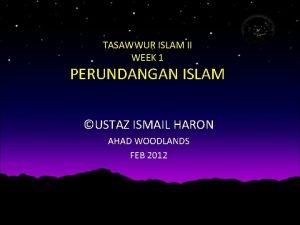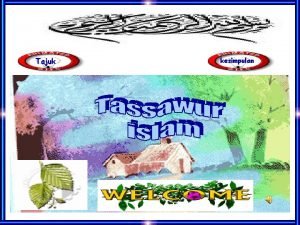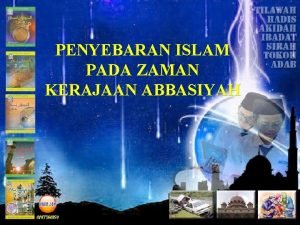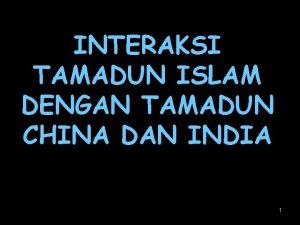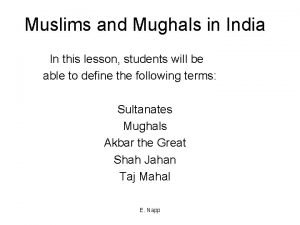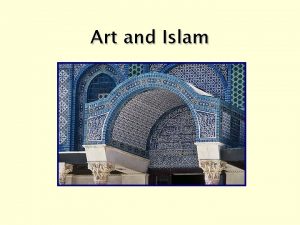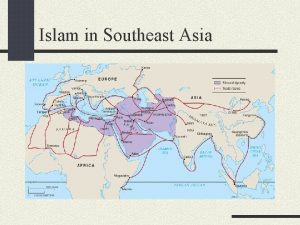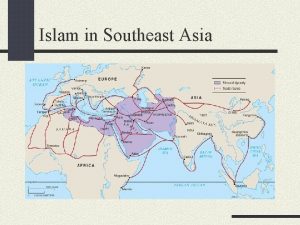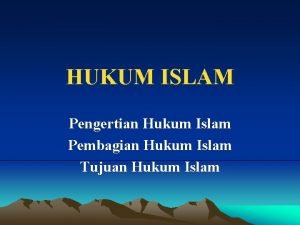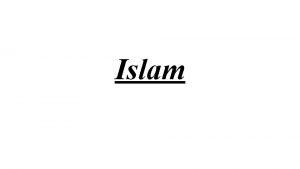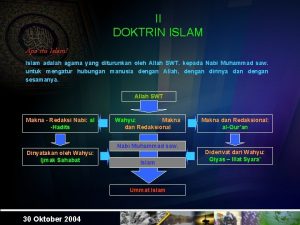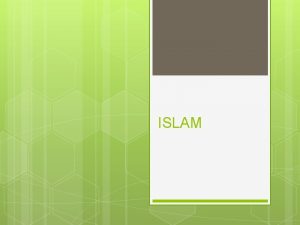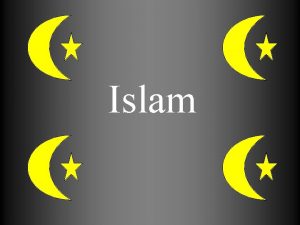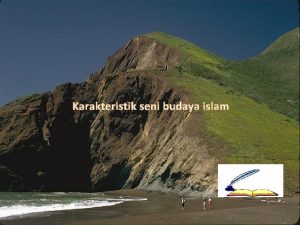India and Islam The Mughals Jan 8 2015
















- Slides: 16

India and Islam: The Mughals Jan. 8, 2015

Review • How long did people normally live in pre-modern societies? Why has the average life-span changed? • How much formal education was available for the average man and women in pre-modern societies? • Could the average person in a premodern Asian society be described as nationalistic?

Modernizing Tradition • Modernization often leads, first, to a repudiation of many traditional practices, customs, and arts and then a return to those traditions in modernized forms. (Martial arts are one example. Traditional music and drama also appear in modernized forms and formats. ) • In the modern world, national cultures often replace local cultures. • We can often find the legacy of tradition in patterns of interpersonal interaction and in patterns of political behavior. • Last class I showed you a clip of Togi Hideki playing a Beatles tune on a traditional Japanese instrument. Here is another example of the modernization of tradition:

Luna Lee • https: //www. youtube. com/watch? v=Nf. OHje. I-Bns • And here is the Togi Hideki video: • https: //www. youtube. com/watch? v=ktj. Hzo. Owc 74

East Asian governments in 1500 • China: a centralized bureaucracy with a very strong monarch, and a bureaucracy selected with a Confucian civil service examination. (Ming China) • Korea: a Chinese-style centralized government, but with a weaker monarch and a civil service staffed by a Confucian scholar class defined both by heredity and by performance on civil service exams. (Chosŏn Korea) • Japan: A fragmented country under the rule of warriors. No civil service examination and no effective central government. (Warring States Japan) • Vietnam: A Chinese-style centralized government with a king, and with a bureaucracy selected with a Confucian civil service exam. Not as much social mobility as China. • The Kingdom of the Ryūkyūs looked Confucian in structure but did not use the civil service exam.

Southeast and South Asia • Southeast Asia has kingdoms, but without the centralized control over the entire kingdom or the non-aristocratic bureaucracy we see in China • Important political entities are Madjapahit (Java), Melaka (Malay peninsula) , and Ayutthaya (Siam) • South Asia lacked the sort of unified strong government we see in China but the many kingdoms there were stronger than the kingdoms of Southeast Asia. In the North, there were sultanates. In the south there were Hindu kingdoms. In Ceylon (Sri Lanka), there were two Buddhist kingdoms plus a Hindu kingdom. • I label the various governments of pre-modern Asia “predatory governments” because they are run for the sake of the ruler rather than for the sake of the ruled (though that is mitigated in some cases by Confucian philosophy). The people are subjects, not citizens. Those governments are governments of the rulers, not of the ruled.

Major trading linkages • South Asian merchants traded with the Malay peninsula and Sumatra (and sometimes with Java) • Overseas Chinese ran trading networks linking southern China with Southeast Asia. • The Kingdom of the Ryūkyūs linked Korea and Japan, and sometimes China, with Southeast Asia • Within maritime Southeast Asia, there was trade between the Spice Islands (Maluku) and points west---the Malay peninsula, Sumatra, and Java. • After 1500, the Portuguese muscled in on this trade.

Religious Geography Today • Islam is the dominant religion in Central Asia, Pakistan, Bangladesh, Indonesia, and Malaysia • Theravada Buddhism is the dominant religion in Sri Lanka, Myanmar, Thailand, and Cambodia • Mahayana Buddhism is the dominant form of Buddhism in Japan, Korea, China, and Vietnam. Confucianism influences China, Korea, Vietnam, and, to a lessor extent, Japan • Tibetan Buddhism is dominant in Tibet and Mongolia • Hinduism is dominant in India. • Christianity is strong in the Philippines (not in 1500)

The spread of Islam • Central Asia: Islam was spread by Arab, Persian, and Turkic merchants (and some Sufi missionaries) who traveled along the Silk Road. (Not all Central Asians were nomads. Some lived in oasis towns rather than moving around in the steppe. ) Among the groups converted were the Uighurs, who used to be Christians. By 1600, Central Asia was mostly Muslim. • Maritime Southeast Asia: Islam was spread by merchants from South Asia. Melaka, on the Malay peninsula, was one early Islamic trading centre. • Why did mainland Southeast Asia stay mostly Buddhist? • South Asia: first Arabs, then Turks, and then the Mughals brought Islam to South Asia. We call the Turkish regimes Sultanates. They were mostly in northern India.

Two types of societies • Nomadic---pastoral societies in which those who rely on flocks of sheep or other such animals for sustenance move regularly with their flocks to find places for their animals to feed. In pastoral societies, horses are important, men are often warriors, and women have more authority than they do in sedentary societies. • sedentary societies--usually agricultural societies rather than pastoral. They need to stay in place to reap the harvest from the grain they sowed months earlier. There also sedentary societies that rely primarily on commerce. They need a set location to store their goods.

The Mughals come to India • Who were the Mughals? Muslim Turks from Central Asia, who also spoke Persian (pp. 154 -160) • Mughal rulers: • Humayun ( 1530 -1540, 1555 -1556) • Akbar (1556 -1605) • Jahangir (1605 -1628) • Shah Jahan (1628 -1658) • Aurangzeb (1658 -1707) Babur (1483 -1530)

Were the Mughals Indians? • Saw themselves as Turkish-Mongolian descendants of Genghis Khan and Timur the Lame. Followed Central Asian Islam • continued Turkish tradition of bloody battles among brothers when their father, the ruler, died. • Enjoyed Timurid gardens, in which they held parties at which they recited poetry, drank, and used drugs. • They like to stay on the move, living in both palaces and tents. • Persian and Turkic were used at court, along with what became Hindi-Urdu.

Resistance to the Mughals • Resistance from the Hindu states of southern India (though Vijayanagara, discussed on p. 153) was destroyed in the 16 th century) • Rajputs ---Hindu warriors from Rajasthan in northwestern India. • Sikhs---a new religious group that took up arms in selfdefence in the Punjab. (p. 160) • Marathas -- a Hindu group from western India who rose up in the 17 th century under the leadership of Shivaji. (p. 160)

Mughal Government • Centralized, but staffed by warrior-aristocrats, who led armies personally loyal to them. (pp. 157 -58) • Collected taxes on agriculture (with the help of zamindars) and commerce throughout the entire empire • Ritual, both secular and religious, was used to enhance the authority of top officials. • Personal nature of ties that held the government together led to fighting at the top over succession, with emperors being overthrown by their own sons. • Sometimes levied a special tax on non-Muslims. (p. 146)

the Mughal economy • Was the world’s leading producer of cotton textiles. Also produced silk, and indigo (a dye) • Had a vibrant internal economy, with goods circulating throughout the empire. • Towns serving as commercial centres appeared all over the Mughal empire, both along the coast and inland. • This commercial activity led to occupational diversification, from weavers and spinners to wholesalers and retail merchants and financiers.

Mughal Culture • Persian language, and the rise of Urdu • Architecture and miniature paintings. • New styles of music (the sitar)
 Impaler state of decay 2
Impaler state of decay 2 How did the safavids consolidate power
How did the safavids consolidate power Maksud fikah tasawwur islam
Maksud fikah tasawwur islam Kesimpulan islam
Kesimpulan islam Perkataan nirleka berasal daripada perkataan
Perkataan nirleka berasal daripada perkataan Interaksi tamadun islam dengan tamadun india
Interaksi tamadun islam dengan tamadun india Hình ảnh bộ gõ cơ thể búng tay
Hình ảnh bộ gõ cơ thể búng tay Slidetodoc
Slidetodoc Bổ thể
Bổ thể Tỉ lệ cơ thể trẻ em
Tỉ lệ cơ thể trẻ em Chó sói
Chó sói Thang điểm glasgow
Thang điểm glasgow Chúa yêu trần thế alleluia
Chúa yêu trần thế alleluia Các môn thể thao bắt đầu bằng tiếng nhảy
Các môn thể thao bắt đầu bằng tiếng nhảy Thế nào là hệ số cao nhất
Thế nào là hệ số cao nhất Các châu lục và đại dương trên thế giới
Các châu lục và đại dương trên thế giới Công thức tính độ biến thiên đông lượng
Công thức tính độ biến thiên đông lượng
